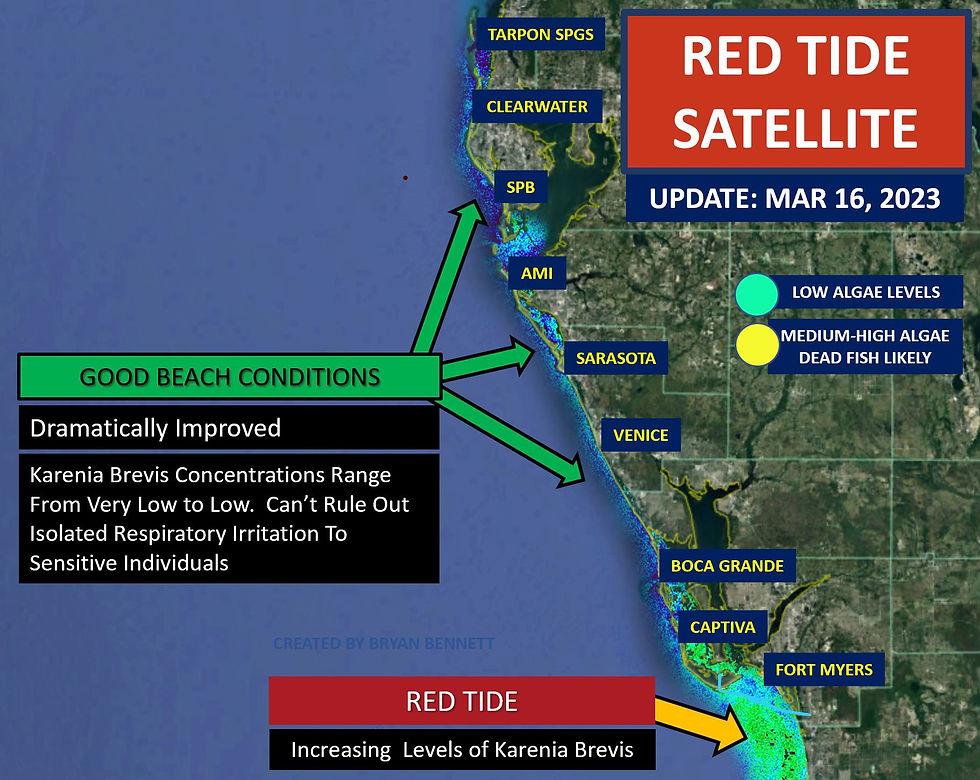Florida Red Tide is Back
- Bryan Bennett

- Mar 1, 2023
- 2 min read
⚠️(RED TIDE – MARCH 1)⚠️ Unfortunately, red tide conditions have worsened along parts of the Gulf Coast of Florida.

BOTTOM LINE:
Many beaches in Pinellas & Manatee County are reporting slight respiratory irritation, but fortunately few reports of dead fish. This means that you may opt to still enjoy the beaches from Clearwater to Longboat Key, but you may experience an occasional cough.
Conditions worsen as you head south into Sarasota, Charlotte, Lee, & Collier Counties with numerous reports of dead fish. Strong onshore winds on Friday will increase respiration irritation and dead fish washing ashore (especially in southern areas).
BEACH CONDITIONS (Provided by Mote BCRS)

➡️ Clearwater Beach (Mar 1): Slight respiratory irritation
➡️ Madeira (Feb 28): Slight respiratory irritation
➡️ Pass-A-Grille/St. Pete Beach (Feb 26): Slight respiratory irritation

➡️ Anna Maria (Mar 1): Slight respiratory irritation
➡️ Manatee Beach (Mar 1): Good
➡️ Bradenton Beach (Mar 1): Good
➡️ Longboat Key (Mar 1): Slight respiratory irritation
➡️ Lido Key (Mar 1): Many dead fish, Moderate respiratory
➡️ Siesta Key (Feb 28): Some dead fish, slight respiratory irritation
➡️ Turtle Beach (Feb 28): Some dead fish, slight respiratory
➡️ Nokomis (Mar 1): Some dead fish, moderate respiratory
➡️ Venice (Mar 1): Some dead fish, moderate respiratory irritation
➡️ Caspersen Beach (Feb 27): Many dead fish, Slight respiratory
➡️ Manasota Key (Mar 1): Many dead fish, intense respiratory

➡️ Boca Grande (Mar 1): Many dead fish, intense respiratory
➡️ Sanibel, Fort Myers (Mar 1): Limited reports due to Ian
➡️ Bonita Springs (Mar 1): Many dead fish, slight respiratory

➡️ Naples (Mar 1): Many dead fish, slight respiratory irritation
➡️ Marco Island (Mar 1): Slight respiratory irritation
WIND FORECAST: Wind direction & intensity is important as it assists in the direction that red tide drifts, controls levels of respiratory irritation, & influences how many dead fish wash ashore. A strong onshore wind brings the worst conditions to the beaches.
➡️ Thu: Onshore (SSW 10 mph)
➡️ Fri: Onshore (SW 20 mph)
➡️ Sat: Onshore (SW 10 mph)
➡️ Sun: Neutral (N 5 mph)
➡️ Mon: Onshore (NW 8 mph)
➡️ Tue: Onshore (NNW 8 mph)
THE SCIENCE:
Hurricane Ian washed an enormous amount of nutrients into Gulf waters and these elevated levels of Nitrogen/Phosphorus are likely contributing to a conglomeration of karenia brevis persisting through the winter. The other primary culprit, polluted/nutrient rich water is being released from Lake Okeechobee (Moore Haven) at 2,000 cfs. That is enough water to fill up a swimming pool every minute. The Lake & the Caloosahatchee River contains nutrients that initiated in central Florida septic tanks & agriculture.
OUTLOOK:
Good news: the area of elevated karenia brevis is narrow and hugging the coast. It's also not heavily concentrated along Pinellas & Manatee Beaches. So, there is hope that this bloom will reduce in coverage or dissipate due to its narrow width & limited concentration.
Bad news: we are reaching the time of the year that is optimal for karenia brevis (warmer water, higher sun angle, etc).
Bottom Line: stand by…. we’ll have to monitor how this bloom progresses as we move into spring break and summer.




Comments